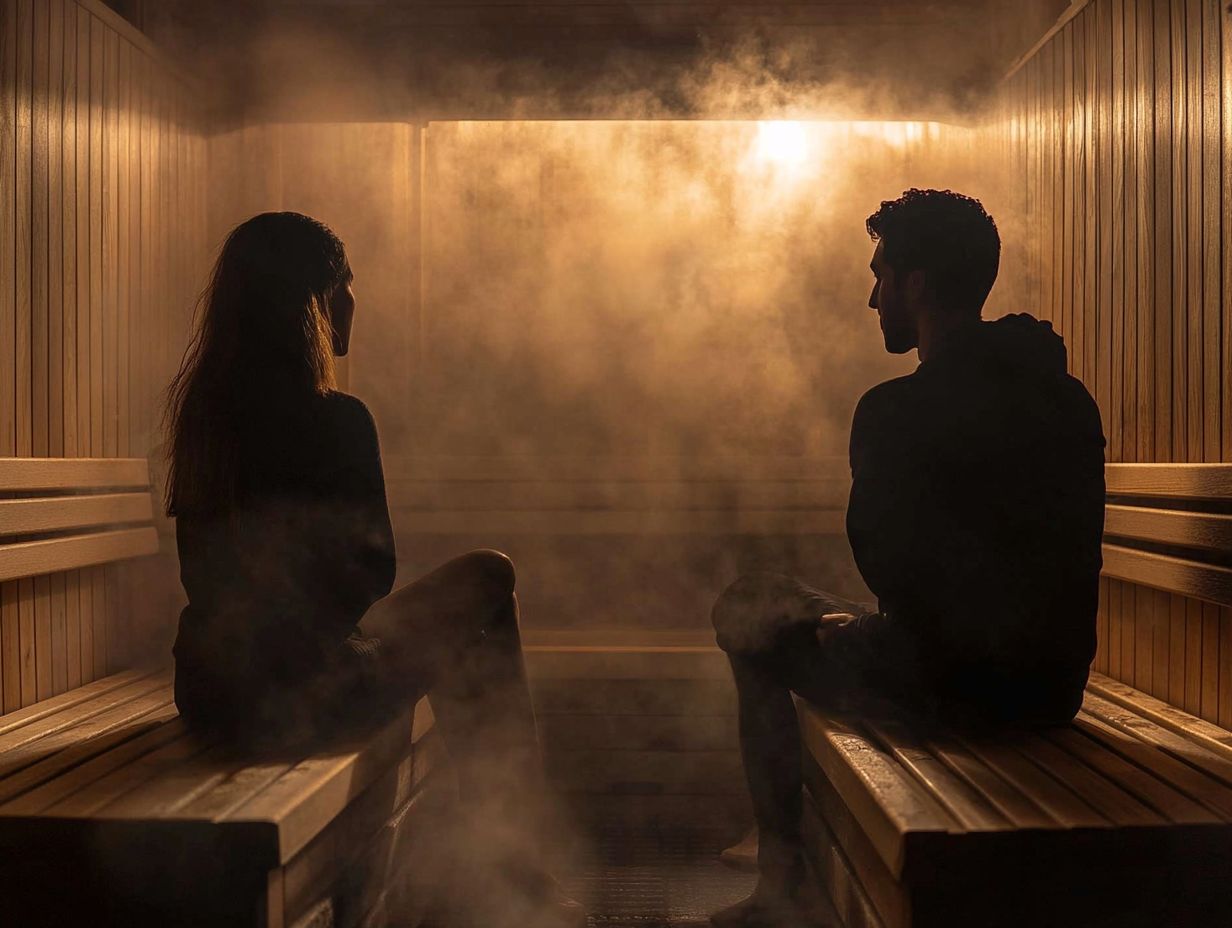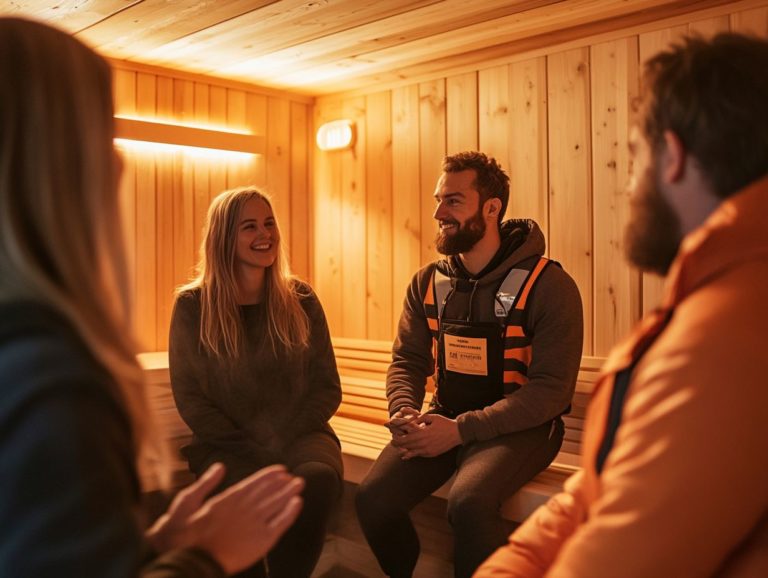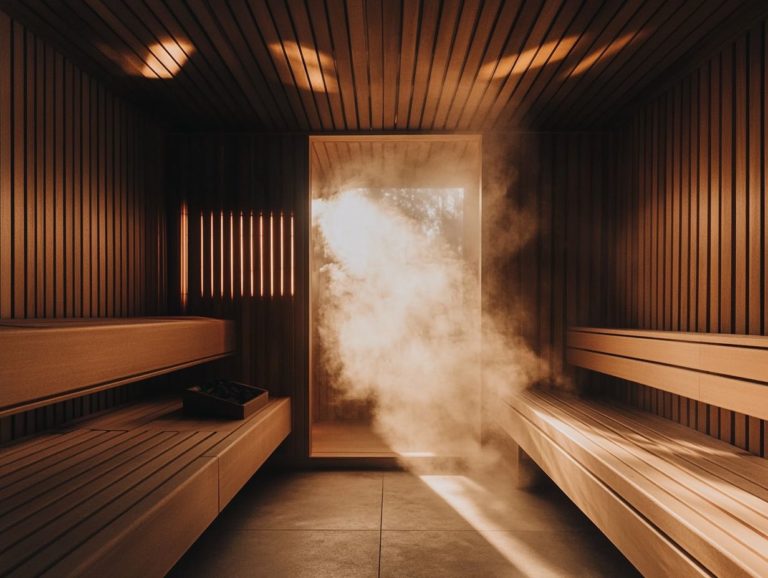Sauna Safety: The Role of Communication
Saunas can truly be a sanctuary for relaxation and wellness, but prioritizing safety is essential to fully savor their benefits.
This article delves into the significance of sauna safety, shedding light on the potential risks and the critical role of communication in preventing accidents.
From clear instructions and the proper use of equipment to essential guidelines and etiquette, you ll find everything you need to navigate your sauna experience with confidence.
We ll also address common injuries and how to steer clear of them, ensuring your time in the sauna is not only enjoyable but also safe.
Contents
- Key Takeaways:
- The Importance of Sauna Safety
- Sauna Safety Guidelines
- Sauna Etiquette
- Common Sauna Injuries and How to Prevent Them
- Frequently Asked Questions
- 1. What is the importance of communication in ensuring sauna safety?
- 2. How can effective communication prevent accidents in a sauna?
- 3. What should be included in a communication plan for sauna safety?
- 4. Why is it important for sauna staff to communicate with guests about safety?
- 5. How can communication help to create a safe and inclusive sauna environment, enhancing the sauna experience?
- 6. What should be done if there is a safety concern in the sauna?
Key Takeaways:

- Clear communication is crucial in ensuring sauna safety, through proper instructions and warnings as well as proper use of equipment.
- It is important to take precautions and follow guidelines before and during sauna use to prevent common injuries such as burns and loss of fluids.
- Respect for others and maintaining safety are key components of sauna etiquette, making communication and awareness essential for a positive and safe experience.
The Importance of Sauna Safety
Sauna safety is essential for anyone wishing to fully embrace the therapeutic benefits that sauna sessions offer, helping you relieve pain and reduce stress. It’s important for ensuring a positive experience. Finnish culture has long celebrated the therapeutic properties of sauna therapy.
The allure of a sauna lies not only in its comforting dry heat but also in its myriad health advantages, such as enhanced heart health and improved cognition, as well as profound relaxation.
However, to truly enjoy this experience, it s crucial to understand the safety protocols and potential risks, such as dehydration, to ensure that your time in the sauna is both enjoyable and safe.
Understanding the Risks
Understanding the risks associated with sauna use is essential for you to maximize its benefits while minimizing potential hazards.
Sauna therapy can be incredibly soothing and beneficial, but it comes with its own set of challenges. For instance, loss of fluids can be a significant concern; prolonged exposure to heat can lead to excessive fluid loss. This effect is especially pronounced for individuals with health issues, such as anxiety or respiratory issues, where your body may struggle to adapt to the increased heart rates that heat can induce. Understanding sauna safety and personal values is essential for a safe experience.
Be aware of your overall health status before using the sauna. While those suffering from a common cold or respiratory health issues might find relief and relaxation during sauna sessions, it s important to proceed with caution. Listen to your body s signals and understand the unique effects heat can have on your specific health profile.
Clear Instructions and Warnings
To ensure a safe sauna experience, it s essential for you to follow clear instructions and pay close attention to the warnings regarding sauna guidelines.
Proper sauna use involves maintaining an optimal temperature of 150 F to 195 F. Set a time limit of 15 to 20 minutes per session, especially if you re just starting out. Make sure to take breaks, drink water, and pay attention to how your body feels; overexposure can lead to discomfort or overheating. If you have any pre-existing health conditions, consult your healthcare provider before diving into sauna therapy to assess any potential risks.
By adhering to these recommendations, you can relish the relaxing and therapeutic benefits of saunas while keeping health concerns at bay.
Proper Use of Equipment

Proper use of sauna equipment is essential for elevating your sauna experience. It maximizes the health benefits of sauna therapy.
In this whole-person wellness approach, you have a variety of options at your disposal. Consider an infrared sauna, which provides deeper heat penetration for enhanced relaxation. Traditional steam rooms envelop you in moisture-rich air. Understanding how to utilize these spaces effectively is crucial; appropriate usage not only enhances relaxation but also stimulates the production of heat shock proteins these proteins help repair cells and improve stress resistance. This leads to tangible improvements in your physical health, such as faster recovery from exercise and improved metabolic function.
By integrating both types of saunas into your regular routine, you can truly harness their therapeutic effects for a more enriching wellness journey.
Sauna Safety Guidelines
Sauna safety guidelines are crafted to ensure you can fully enjoy the myriad health benefits that come with sauna sessions while steering clear of potential risks and complications.
Precautions to Take Before and During Sauna Use
Before and during your sauna sessions, it s essential to take specific precautions to ensure a safe and enjoyable experience. Make hydration your top priority! The heat can dehydrate you faster than you might expect. Regularly sipping water before and during your time in the sauna is vital.
Keep a vigilant eye on your body temperature to avoid overheating, especially if you’re more heat-sensitive. Knowing your personal limits is particularly important if you have chronic pain, as sauna therapy can help reduce inflammation and enhance relaxation, or respiratory conditions, as your body may respond differently to elevated temperatures.
Listening to your body can truly enhance your enjoyment of all the incredible benefits sauna therapy has to offer!
Sauna Etiquette
Understanding sauna etiquette is essential for cultivating a serene environment, allowing you and others to fully enjoy the unique sauna experience without discomfort or interruptions.
Respecting Others and Maintaining Safety

Respecting others in the sauna is crucial for ensuring both safety and a positive atmosphere for everyone involved.
In this shared sanctuary, it s important to be mindful of your behavior and the comfort levels of those around you. Keeping conversations to a soft murmur and avoiding overly personal topics helps maintain personal space and privacy. By creating an environment free from disturbances, you can truly immerse yourself in the soothing heat, allowing your body to unwind while you enjoy tranquility.
Ultimately, this mutual respect cultivates a sense of community and enhances the rejuvenating benefits of your sauna experience.
Common Sauna Injuries and How to Prevent Them
Being aware of common sauna injuries and their prevention is essential for anyone seeking to enjoy the benefits of sauna therapy without encountering adverse effects.
Burns, Dehydration, and Other Risks
Burns and dehydration rank among the most prevalent risks tied to sauna therapy. It is essential to pay close attention to safety measures.
To ensure your experience is both safe and enjoyable, monitor the sauna s temperature and maintain optimal hydration levels. Know the safe heat exposure limits; they typically range from 150 to 195 degrees Fahrenheit. Allow your body to acclimate at a comfortable pace.
Stay well-hydrated before your sauna session and sip water intermittently during it. This practice can significantly reduce the risk of dehydration. Additionally, be attuned to your comfort levels; any signs of overheating or excessive sweating should be taken seriously as they may lead to negative effects on your body. For more information on safe practices, check out sauna safety and advocacy.
Addressing Other Potential Risks
While burns and dehydration are certainly well-known risks, other potential concerns linked to sauna use warrant your attention.
For instance, muscle spasms can arise from prolonged exposure to heat, placing unnecessary strain on your muscles and joints. Sauna sessions can significantly increase your heart rate, which may be concerning if you have existing heart issues.
It’s crucial, especially if you re managing anxiety or chronic pain, to recognize your personal limits while using a sauna. Listening to your body and having a clear exit strategy is vital.
To ensure safe sauna use, consider these strategies:
- Start with short sessions
- Stay well-hydrated
- Monitor changes in your heart rate and overall feelings throughout the experience
Implementing these practices can help mitigate risks while allowing you to enjoy a relaxing sauna experience!
Frequently Asked Questions

1. What is the importance of communication in ensuring sauna safety?
Communication is key for sauna safety! It helps everyone stay informed about potential dangers or concerns, and to coordinate actions in case of emergencies.
2. How can effective communication prevent accidents in a sauna?
By sharing important information such as temperature settings, maximum occupancy, and safety rules, everyone in the sauna can be aware and take necessary precautions to avoid accidents.
3. What should be included in a communication plan for sauna safety?
A communication plan for sauna safety should include emergency contact information, safety rules and guidelines, and a designated person responsible for monitoring and addressing any safety concerns, including potential dehydration risks associated with sauna use.
4. Why is it important for sauna staff to communicate with guests about safety?
Sauna staff have a responsibility to ensure the safety and well-being of their guests. By communicating safety measures and rules, they can prevent accidents and create a more comfortable and enjoyable experience for all.
5. How can communication help to create a safe and inclusive sauna environment, enhancing the sauna experience?
By promoting inclusivity and respect for all individuals using the sauna, everyone can feel comfortable and safe. This can also help prevent any discriminatory or harmful behavior.
6. What should be done if there is a safety concern in the sauna?
If you notice a safety concern in the sauna, such as a potential issue affecting heart health or respiratory health, it is important to communicate it to sauna staff or other individuals present. This can help prevent accidents and ensure everyone’s safety.






